Most of this season is pressing your nose against the window and staring out into the bleak winter weather. Fortunately, that's not always true.
I had transplanted a young marigold indoors in early October just before frost. That bloomed reliably until about two weeks ago when it finally gave up. I planted some celosia seeds in a tray pack and those are happily growing on my windowsill now, enhanced by a 6 watt LED bulb an inch away. It should be ready for transplant into the windowsill pot around the second week of January.
I ordered my gardens for 2015 from Park Seed and Swallowtail Garden Seeds. Swallowtail is a new company for me, they have Figaro dahlia seeds by color instead of as a mix. Since the taller dahlia performed so well in the gardens in 2014, I had wanted to expand their usage next year.
For the most part, the plants are the same as last year. However, the color design calls for decreasing the orange and increasing the red to compensate. To accomplish that, half a flat of Figaro red dahlia and an extra flat of Magellan scarlet zinnia are called for.
The Profusion zinnia also perform very well, so I've increased their usage in the garden. I favor the Fire, a very reddish orange, but the yellow were well-received as well. The orange is very nice, but as I'm cutting back use of orange in the garden next year I'll be using fewer of those.
Purple hues are new for me in 2014, and to work with the Blue Boy dahlia (actually a deep purple), I added Figaro purple dahlia as well. The colors vary considerably among the plants, but all are more than close enough to accent the Blue Boy.
Friday, December 19, 2014
Winter Gardening
Saturday, November 15, 2014
2014 Lawn Additions
Lawn additions, like the garden, were very similar to last year. About the only changes were the addition of a little cracked corn early on to combat a slight case of snow mold I'd had during the winter, and the reduction of the winterizer amount to 0.87 pounds of nitrogen per thousand.
That reduction was also to fight any potential snow mold this winter, as well as to account for the fact that winter descended a little early--and that was all the fertilizer I had left!
| Date | N | P | K | Iron | Organics | Other Notes |
| 5/13/2014 | 1.21 | 0.21 | 0.34 | 0.00 | 25.0 | Soybean Meal, Cracked Corn |
| 8/1/2014 | 1.05 | 0.30 | 0.15 | 0.00 | 15.0 | Soybean Meal |
| 9/5/2014 | 1.05 | 0.30 | 0.15 | 0.00 | 15.0 | Soybean Meal |
| 10/1/2014 | 1.05 | 0.30 | 0.15 | 0.00 | 15.0 | Soybean Meal |
| 11/12/2014 | 0.87 | 0.00 | 0.15 | 0.00 | 0.0 | Vigoro 29-0-4 |
| Total per K ft: | 5.23 | 1.11 | 0.94 | 0.00 | 70.0 | 700 active organic total |
2014 Garden Additions
Garden additions were around the same as last year, just somewhat better distributed monthly. The heavy-hitter was Milorganite, as usual, with only a small boost of ferrous sulfate in July to deepen leaf colors slightly as the calcium I added kicked in.
| Date | N | P | K | Iron | Organics | Other Notes |
| 5/5/2014 | 0.55 | 0.22 | 0.00 | 0.44 | 11.0 | Milorganite |
| 6/1/2014 | 0.90 | 0.36 | 0.00 | 0.72 | 18.0 | Milorganite |
| 7/1/2014 | 1.05 | 0.42 | 0.00 | 1.42 | 21.0 | Milo, Ferrous Sulfate |
| 8/1/2014 | 0.90 | 0.36 | 0.00 | 0.72 | 18.0 | Milorganite |
| Total per K ft: | 3.40 | 1.36 | 0.00 | 2.48 | 68.0 | 136.0 active organic total |
Does Milorganite Deter Rabbits?
Another Dear Reader question.
The answer is "no." I've never noticed that Milorganite did anything to deter rabbits from the lawn or gardens. For about the first twelve hours or so, it may discourage them a tiny bit, but the initial scent fades quickly and after that there's no impact on rabbit populations.
What will work is a simple spray:
1/2 tbsp Tabasco sauce (or any hot sauce, the hotter the better)
1/2 tsp dish soap, any kind
1/4 tsp Elmer's glue (optional, but helps it stick)
32 ounces water
Spray on plants, only a mist is necessary. The flavor is distasteful to rabbits and repels them very well.
That formula is very give or take on amounts, and it's about where I am at the present moment via experimentation of what works best to repel the beasts and also has some staying power on the leaves. This will be good until the next rainfall and even beyond that if the rainfall is light.
Tuesday, November 11, 2014
Iron on the Lawn
It was a bit of a speed application this afternoon and evening as sunset gets a bit earlier every day, so my coverage was perhaps a bit thin.
However, I managed to spray 4 ounces of ferrous sulfate monohydrate onto the lawn per thousand square feet, mixed with about an ounce and a half of Miracle Gro (I'm out of ammonium sulfate and didn't notice that until too late). I used sodium laureth sulfate as a surfactant, somewhat under a tenth of an ounce per thousand square feet.
In this case, given the limited time and limited amount of spray I could get down, I went with a somewhat more dense solution than usual. All of the above per thousand was mixed into slightly under a gallon of water. That won't be an issue, and temperatures tomorrow are forecast to go no higher than 60°. Post that, temperatures tumble for the foreseeable future, with highs in the forties or colder.
Fortunately, the weather was very humid with dew expected this evening, so the grass should stay damp until well after sunrise. By tomorrow mid-day, the color will be deepening. The impact of this iron application will continue right through spring as grass growth is about to stop for the year.
Monday, November 10, 2014
Dahlia and Moles
It turns out I seem to have a few moles in the garden. They ate the Blue Boy dahlia tubers, except for one clump. Fortunately, that one clump had six tubers with eyes on it, which means I have two more Blue Boys than I started the season with!
The Color Spectacle came up beautifully, with two tubers dividing initially into six.
Today also marked the evening I finished taking down the gardens, assembling the compost bin, and getting that started. In the last six hours, it's already risen to 96° in the bin. By tomorrow, temperatures should be pushing 130°.
The weather looks likely to turn wintery by the end of the week with very little warming through the remainder of November. I may spray iron and drop winterizer tomorrow and Wednesday.
Thursday, November 6, 2014
Lifting Dahlia
The first very heavy frost was the night of October 31st, so an appropriate Hallowe'en occurrence.
Dahlia do best if given five to ten days to harden off after frost, so I delayed lifting them. We're supposed to get moderate rainfall tomorrow, so I started lifting this evening. I had enough time to lift the two Sky Angel dahlia and five Sun Lady.
Which are now four Sky Angel dahlia and ten Sun Lady. The tubers did very well this year in the gardens, with divisions in half required. Technically I should have divided the tubers further, but I'll do so in spring when the eyes are clearer and beginning to sprout. It's likely that I'll get another doubling out of this year's tubers.
I still have to lift the Blue Boy and Color Spectacle, but that will have to wait until after this storm system moves through.
Wednesday, October 22, 2014
The Last Soybean Feeding
I forgot to mention it before--the final feeding of soybean meal on the lawn went on September 28th. Since it didn't rain until early October, I'm entirely comfortable calling this the October feeding of the lawn.
As always, I used 15 pounds per thousand square feet, or approximately 7 pounds of protein. That's right around 1 pound of nitrogen equivalent per thousand square feet, or more than sufficient to carry the lawn through the end of the season.
This doesn't quite finalize the lawn feeding. Winterization with a good synthetic (I chose Vigoro 29-0-5 again this year as it's cheap and effective) will happen when top growth stops. Normally, that's around Thanksgiving, give or take a few weeks.
Once I winterize, I'll post the charts of all additions to the lawn and garden for the year.
Sunday, October 19, 2014
Mid-October Lawn Photos
Plus the gardens, of course. First frost is most likely tonight as the temperature is 39° and dropping at just before 7 PM. Today was the last chance to take garden photos for the year, even though a few plants will survive this evening and continue to blossom into November.
First, the lawn photo. This one isn't quite the typical shot as the sun was lower than usual. To avoid catching my own shadow in the image, I turned a bit further south than I usually do. As always, click to embiggen and see how badly the lawn needs mowing (very badly).

Here are the Color Spectacle dahlia, plus red salvia and a few rather sad-looking late zinnia. The dahlia will be making an encore appearance next year.
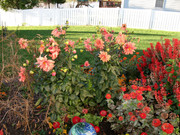
A more southern face of the garden, featuring yellow Sun Lady dahlia, a few remaining marigolds, and more Color Spectacle.

The red salvia certainly do hang on well. So, it seems, do yellow Janie marigolds, which are also planned to appear again next year. Very few marigolds output flowers like this in October.
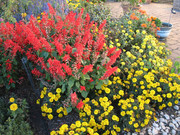
Sunday, October 5, 2014
Early October Photos
Last night wasn't quite first frost, although some of the zinnia in the lower parts of the back beds had their flowers blasted. Still, it looks like identical weather tonight and Monday, and then we warm up again.
As always, click on a photo to embiggen it.
This is the standard lawn shot, now with extra dogs (which were out at the time the photo was taken). Riley is clearly concerned that the more-distant Casey might be having fun he's being left out of.

The back gardens are doing well, although the cleome seems to be reacting to the colder weather as well. That can be removed when I have time and ground up for the compost bin. The dead grass at the garden edge is where I re-imposed the edging that walked inward over the course of the season, and I generally spray it twice a year in July and September.

The front gardens are doing fairly well, too, although you can see the places where some plants have been removed for the season as they gave up.

More extensive use of dahlia is new for me this year. This is a Color Spectacle dahlia, quite cheap at Home Depot in very late spring. My apologies for the poor photo. The flowers are huge, so I have to back off enough for you to see the entire thing, but doing so required me to move into a bad spot.
Blossoms are more rare than other dahlia, with both of these plants hosting around 12 blooms at a time.
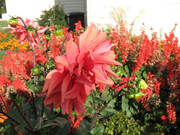
This is another dahlia, the much more standard Sun Lady. Flowers are around 4" across, and erupt copiously on a 40" plant. This particular dahlia has around 25 blooms on it currently--as do the other four Sun Lady in the garden. That's after cutting at least twenty for vases and for gifts this week.
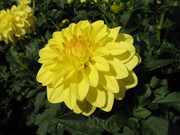
Yet another dahlia, the Blue Boy. It's a semi-cactus in a fairly pure purple (the color is somewhat darker than pictured here). Flowers are close to 6" across on 24-30" plants, and the plant blooms copiously (as you can see by the other blooms in the shot).

Sunday, September 21, 2014
Seed Collection Continuing
There hasn't been terribly much to write about for the last few weeks. The gardens are looking great, and I discontinued feeding two weeks ago. They can glide through the remainder of the season on what remains. So far, the season is certain to continue into early October and there's no frost in the forecast. It's actually been exceptionally warm and dry for September.
Most of the seed collection is complete for the year. A few plants won't be collected as they reseed themselves so easily they don't need to be (Cleome are almost in this range), or the seeds don't breed true (hybrid zinnia and dahlia). I order those every year, although I do remove and store dahlia tubers for plants that have performed particularly well.
The varieties I collected are listed below.
Ageratum: Many people report that this plant doesn't work well for them, but it volunteers easily in my gardens and gets absolutely huge (for a dwarf plant). This is the first year I tried to save seed for sprouting, so we'll see how that goes.
Celosia: Descendants of China Red that crossed with my off the shelf red, orange, and gold varieties. I tend to choose the ones that show the characteristics closest to the original China Red, but yellow, orange, and red still volunteer in the garden so the mix stays variable.
Cleome: While the parents were Sparkler Rose, the granddaughters are firmly split into pink, a pink-purple, and purple, or the normal cleome colors. I've collected seeds from the darkest of the purple plants to try to bias the selection in that direction a bit.
Easter Eggplant: So far this one isn't quite done, but I tend not to finish until October here anyway to give the eggplants time to mature on the vine.
Marigold, orange: Amazingly, these breed very true even with yellow marigolds very close to them. A rare surprise in the color mix certainly isn't a problem.
Marigold, variegated: These have single to semi-double blossoms, streaked with color. The daughters are usually a surprise and can show primarily reds, yellows, or even bands of color.
Marigold, yellow: While these cross with the orange and sometimes produce a surprise, it's amazing how often they breed true (probably 95%). I always have spares, so a few orange ones in the mix with the yellow flat isn't a problem, and they're always blooming by the time they're ready to go out in spring.
Melampodium: Also called star daisy (they aren't daisies), these plants reseed themselves freely in most Pennsylvania gardens. Two or three of the plants in the gardens were volunteers, the rest were grown. One hundred percent of my mother's plants are volunteers. Over the years, these seem to be getting a bit larger and a touch more gold than yellow, but I don't mind. The great-granddaughters of these plants are prettier than the originals.
Salvia splendens: A nice red saliva, the great-granddaughters of the set I used to have. They're tending taller over time, with a larger blossom and better, truer reds. As the generations move on, more are volunteering in the gardens than used to.
Salvia farinacea, Rhea: Still small and purplish-blue, these have become a staple in the garden. They're petite and very pretty, all season bloomers, and even volunteer fairly freely in the garden.
Monday, August 11, 2014
Rain, Finally. Maybe.
Typical for summer, we just had a two week dry period. Lawns around me are going into dormancy and those that are avoiding it are either being irrigated or are more fescue.
My back neighbor has responded by watering twice a day--exactly the wrong response as this encourages lawn diseases, intensifies any diseases you have, and results in very short roots on your lawn. Additionally, it costs a fortune in terms of water.
I irrigated once during this period, just a few days ago. Even so, the lawn is dry and we do need rain. There's a 75% chance of it tomorrow, and 90% on Wednesday, and we may get up to two inches.
So from drought to deluge. I'll take it.
Saturday, August 9, 2014
Early August Images
The lawn is probably at its low point for the year, while the gardens are at their high point. So far, the gardening season has been a little touch and go due to the weather and the rabbit invasion in May and June, but it recovered nicely from both.
First, the standard lawn shot. You can see some shock on the grass if you look close, and rain isn't expected until Wednesday (and then not terribly much). This week marks the third time this year I've watered.

The general garden shot, taken from the side this time. Yes, it's busy. I like it that way, as do the bees and hummingbirds.

This is an orange zinnia that happens to have lots of friends. Out of focus in the background you can just barely see the yellow carpet (Profusion) zinnia, and some blue salvia.

There's a ton of very happy Harlequin dahlia in the garden this year. Harlequin grow 12 to 16 inches tall (mine tend toward 16 inches or a bit taller as I feed well), flower heavily from early summer to frost, and like any dahlia can be lifted and saved for the following year if you wish to do so. Second year tubers tend to outperform first year plants.

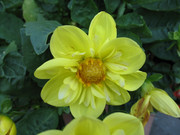

Cutting dahlia are always nice! This is a Sky Angel dahlia that grows about four feet tall, and produces copious lavender blossoms on very long stems. Cutting these dahlia results in even more blooms produced. I picked this up very cheaply at Home Depot some years ago, and store the tuber over the winter in a paper bag.

Since the cannas gave up, I planted Blue Boy, Sun Lady, and Color Spectacle dahlia. The Blue Boy are starting to blossom, and this first flower is just opening. The color is inaccurate, however, as in person it's almost a perfect violet, but a bit less saturated than the full color. The open bloom (which I'll photograph), will be about four to five inches across.
Like the Sky Angel, this is an excellent cutting dahlia that can be purchased at Home Depot in late spring.
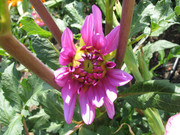
Last but sure not least are the Easter Eggplant this year! The first image is of the plants in pots, the second is of the developing eggs close up. You'll note I do need to de-shag the plants a little bit and remove the yellowing older leaves. As the season rolls on, more leaves will yellow, exposing the eggs when I remove them.

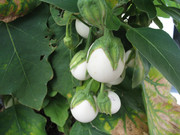
Wednesday, August 6, 2014
Happy Solar Autumn!
Technically, August 5th marked the first day of solar fall (or solar autumn), but I missed that.
Solar Autumn is the twelve week period of the year when the day length (in the northern hemisphere) decreases the fastest. Between now and November 5th, the Sun's declination (a measure of how far north or south it is of the celestial equator) will change from +16° to -16°, or moving roughly 32 degrees (I rounded the numbers). Since between June 21st and December 21st, the total change is only 47°, you can see why this period is the fastest change.
Your day length will vary by where you are on the globe. Mine changes from today's 14 hours (and a bit) to 8 hours and 20 minutes on November 5th.
Depressing as it might be, the upside is that summer certainly isn't over yet! We still have more than two months of gardening time left, although the last few weeks of that are touch and go. Lawn season continues for another three months.
Thursday, July 31, 2014
Rabbit Protection Working
The Tabasco sauce recipe I started using at the end of June is working perfectly. I have no additional rabbit damage a month later, and the damaged plants have regrown beautifully.
Rabbit populations seem to have fallen a bit, possibly as they spread out for food sources now that my garden is no longer palatable.
I did observe one rabbit this morning try to nibble on the zinnia. He or she spit out the leaf immediately and left for the neighbor's clover!
Saturday, July 26, 2014
Late July Photos
The general lawn photo first. This part of the lawn isn't particularly dry, although we could certainly use some rain at this point. Fortunately, it's supposed to rain tomorrow and Monday.
As always, click on the image to embiggen.
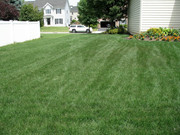
I photographed the front garden in perfect morning sun last time. This time, it's later in the afternoon so the light is glaring off the leaves and flowers a bit. Still, you can see the development it's gone through in a few weeks.

The back gardens are finally improving now that I've successfully repelled the rabbits from the zinnia. This is taken from near the walkway, which is being slightly overgrown by a rather happy Harlequin dahlia.

From further around the back of the garden you do start to see where the rabbits were feeding. These plants have essentially only had decent growth for the last three weeks, but they're quickly catching up to where they should be.

Saturday, July 5, 2014
July Photos
July Fourth is traditional for lawn and garden photos, but I was at a picnic that ran until well after dark. The fifth of July will simply have to do this year.
Here's the standard lawn photo. You can see some slight burning where the late June dry spell took a slight toll on it. Color and quality are fair this year. As always, click to embiggen.
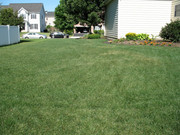
This is a wide shot of the back garden, showing off the lawn as much as the gardens.

Here's the general garden shot across the back gardens. Garden development has been so-so overall, but now that the rabbits have been repelled things should improve very quickly.

I have extremely happy dahlia this year as they don't mind (and in fact like) hot and humid weather with little rain. This is a Harlequin dahlia that I grew from seed, technically a dwarf decorative dahlia but it looks like a collarette dahlia to me.

Two more dahlia for your viewing pleasure. These are also Harlequin.


Tuesday, July 1, 2014
How To Repel Rabbits
Yes, I finally have a series of things that works to repel rabbits even under extremely high population pressure! I've used this successfully on my zinnia, gladioli, and sunflower.
First, I found that just the tiniest sprinkle of blood meal around the plants helped considerably. Damage from that alone was reduced by a solid 90%. I spread it slightly wide into the surrounding areas to make sure the rabbits scented the blood before they entered the garden. The three pound bag I purchased for $7.50 should last around 3-4 years when used to protect 150 plants.
The second part of the solution was a slight modification of a recipe I found online:
In a 1 gallon sprayer, mix:
0.5 Tbsp Tabasco sauce, any brand but the hotter the better
0.5 tsp dish soap, any brand
0.25 tsp Elmer's glue (optional, to help the Tabasco stick)
You may scale the recipe any way you like; I make this 16 ounces at a time to fit into my small spray bottle.
Spray the plants moderately the first time, a gallon should be good for around 1,000 small plants, 16 ounces covers 150 small plants. Respray moderately if it rains, as soon as possible after the rainfall.
Even if it doesn't rain, spray lightly each successive day for a week to keep the scent and flavor fresh and very hot. 16 ounces will lightly spray about 300 small plants.
After that, the rabbits have probably learned to leave your garden alone, but if you notice further damage respray the plants as necessary.
Do not spray vegetables that will be harvested shortly. Although harmless, the flavor of the Tabasco sauce will be apparent on your veggies.
Monday, June 30, 2014
Tabasco Sauce to Repel Rabbits
I tried the Tabasco sauce recipe from 2 posts below and so far...so good!
I gave the plants a fairly heavy application (a quart over all the zinnia that remain) yesterday. As of this morning, there's no additional damage. I then sprayed lightly today, and will continue to do so for at least a week (spraying heavily if we get rain or I water).
Sunday, June 29, 2014
June Lawn and Garden Photos
It's been way too long since I've posted photos, although so far the year has been poor to fair at best. The weather has been hot and flips randomly between soaking wet and very dry and, if you've kept up with my blog so far, the rabbits this year are voracious and very numerous.
I was up working very early this morning, so I managed to get photos of the front lawn and gardens fairly early and with the sun at a good angle.
First, the front lawn photo. There's a slightly burned area where I'm standing that doesn't appear in the shot. As always, click to embiggen.

This is the front garden, which is suffering less from the rabbit damage since I cut back the rhododendron. You can see a damaged section of lawn to the middle left, and this is post-mowing so the dry lawn shows more. Again, click on the image to make it larger.

Saturday, June 28, 2014
Blood Meal to Repel Rabbits
My zinnia are under so much pressure from the rabbit population that some of them are down to sticks. Those are probably going to die, but there's hope for those that still have leaves.
Most years, just black pepper works. This year, very little seems to be working.
I just applied 20 pounds per thousand of Milorganite as it does, temporarily, help. I also applied about 1 ounce per square yard of blood meal, which supposedly helps repel rabbits as well.
One other thing I've seen suggested is spray with diluted Tabasco sauce. One ounce per gallon should be sufficient, spray lightly, and repeat after rainfall. I'll pick up some generic Tabasco today and try it out.
I'll take photos later today, but I plan on skipping the denuded areas of the garden.
Sunday, June 22, 2014
Rose Pride on Zinnia
I sprayed the maturing zinnia with Rose Pride fungicide today. This serves two purposes.
Rose Pride (Triforine) is both a contact and systemic fungicide that helps control powdery mildew. PM can be a major issue on Magellan zinnia, and this will keep it at bay through early August at least. As a general rule, PM becomes an issue on zinnia later in the season when they've grown into each other and when they're nearing the end of their growth periods, but Rose Pride can be reapplied every 7 to 10 days if needed.
The smell and taste of Triforine are unpleasant, which will tend to repel the rabbits that are still making a terrible mess of my southwestern face. This year, the number of rabbits is particularly high, and I frequently see four or five simultaneously in the yard. I've found that Rose Pride helps deter rabbits for periods of three weeks or so, by which time they've either moved on to better food sources or the plants have matured enough that the rabbits are considerably less interested.
Wednesday, June 18, 2014
Cannas Get Old
Canna bulbs can be lifted every fall just after frost and planted again in spring after proper storage.
Unfortunately, after many seasons and repeated tuber reduction back to the core plant to decrease the size, they do get old and cease blooming. That was the state of affairs this year in the garden, where I planted 7 canna tubers and 3 have grown. The ones that grew, grew poorly.
I've changed my habits a little bit and replaced them with three types of dahlia. That bed now features Blue Boy, Sun Lady, and Color Spectacle dahlia, all of which grow 3 to 4 feet tall and feature flowers from 4" across to 10" across for the Color Spectacle.
Finding information on Sun Lady is difficult, but it's a decorative dahlia that grows 3 to 4 feet tall under normal circumstances, and features sunny golden blossoms that are around 4" wide. Blue Boy is identical, except that the blossoms are purple-blue.
Color Spectacle features large, coral-orange blossoms with white tips in a semi-cactus style. While blossoms can be ten inches across, I don't intend on removing the side blossoms so mine will be smaller (but also far more numerous).
Friday, June 13, 2014
Milorganite's Potassium and Operation
I've received two more Dear Reader questions!
Question: does Milorganite really work?
Answer: yes. However, if you're used to the mode of operation of synthetic fertilizers, you may not think so at first. It takes two to three weeks (in normal weather) to decay into the soil and begin to feed the plants, and the level of feeding it supplies is never as extreme as a synthetic. Any growth spurt you get will be very minor, and mostly fueled by the small amount of free nitrogen in Milorganite. Other fertilizers, like soybean meal, have no free nitrogen and won't set off any spurt of growth at all.
Most organic fertilizers have a slowly building positive effect over time as you use them. The first year, the grass and gardens just look better. That improves the second year. And so on. Eventually, growth is always at the optimal level for the time of year because food is always available when the plant wants it. That takes some time, however.
Question: Milorganite has no potassium, correct?
Answer: incorrect, actually, but you can think of it as 0 if you want. Milorganite is 5-2-0, which means that the potassium (the third number) doesn't consistently measure at 1% or greater. That doesn't mean zero potassium, merely that it's less than 1% of the mass. If I remember correctly, Milorganite is just under 1%.
Whether you need potassium or not is something only a good soil test can tell you. In my case, my soils have entirely sufficient levels and no more is required at the present moment.
Sunday, June 8, 2014
Watering in Organics
Yet another Dear Reader question in a banner year for such things. Keep them coming--I can get them from comments on articles, search terms used to find this blog, and direct e-mail for those of you who know me personally.
Question: how much water does it take to water in organics?
Answer: none. Organics don't need watering in, but when using them in the gardens you may want to do so just to wash the bits and pieces off the flowers and leaves.
And yes, I know what you really mean. Most organics will begin to activate when they're touching the soil and damp, so not much rain is required. If they dry out, decay will stop (for the most part).
Continuously dampened organic material will decay into the soil the fastest. Fortunately, a damp soil will dampen the material nightly and allow decay to continue. Rainfall will wet it and accelerate decay. Any watering you do will help, just like rainfall will.
Some of the best conditions I've seen for activating organic feedings are when the weather is overcast with occasional drizzle for several days. Remaining constantly damp, the organics decay in very quickly.
Extended dry periods will stop organic decay, but the lawn and gardens won't be feeding heavily during a drought--if they're feeding at all. Hold any additions until the weather changes as organic feedings could build up on the soil, leading to a rather aromatic decay when it finally does rain.
Saturday, June 7, 2014
Ironite on Dogwoods
Another Dear Reader question! Can I use Ironite on dogwoods?
Answer: A technical yes, but...
If your dogwood is showing signs of iron deficiency like widespread yellow leaves in spring and summer, iron deficiency is one possible problem (magnesium shortages, nitrogen shortages, too much or too little water, or half a thousand other things are also possibilities).
First, get a soil test (I say that a lot). Pay attention to two things: soil pH and iron levels. If iron is OK but pH is high, iron might help temporarily but you're likely to return to the original conditions pretty quickly. If iron is low and pH is under 7.0, iron deficiency is more likely.
In the latter case, Ironite might help. However, it's a rather expensive way of adding limited iron without otherwise doing much for your tree. In this case, and given the small area that trees tend to encompass, I'd recommend using Milorganite at bag rate under the drip line of the tree. It contains slightly more iron, plus helps feed the tree.
In the former case where your pH is over 7.0, Milorganite will help by adding some organic material to the soil. Iron likes to bind to organic matter, and releases from it more easily than from the soil, so over several years of monthly use you should notice a steady improvement in your tree.
In most cases, I don't recommend trying to reduce your pH if it's very high (7.8 or above). This is more common in lower rainfall areas of the nation, and quite rare where I live. While adding sulfur might help a bit, sulfur is much more effective if dug into the soil and in soils that don't have free lime. Very high pH with very high calcium levels is an indication of free lime.
Overused Flowers
Several times now, I've heard a few flower choices (including some of my own) criticized as "overused," or a plant that everybody has and that everybody is tired of.
Well, not everybody! There are excellent reasons for some common choices. Not everybody has sufficient time to maintain difficult plants, or the appropriate conditions for them. Some of us (like me) have enormous gardens and can't specifically pay attention to 800 plants--we rely on easy, attractive flowers to fill out the majority while a few specimens function as highlights in our gardens.
Probably the most-frequently criticized flower in my garden is the French marigold. They're available, and inexpensive, by the flat at any garden center. They're durable, tolerant of most conditions except for extremely acidic, extremely alkaline, or full shade, and bloom like troopers even in the hottest weather. They'll even tolerate a very light frost, although generally not without damage. The flowers are long-lasting, the plants are reasonably drought-tolerant, and although they benefit from dead-heading, it's not absolutely required. They bloom from shortly after planting to the time they die.
What's not to love about that? If you look around, there are dozens of varieties of marigold, both French and African, in many hues of mahogany, burgundy, yellow, gold, orange, and bi-colors. Most recently, some almost-red varieties have been developed, although they're still noticeably mahogany if compared to a more perfectly red flower like a zinnia.
That's merely one example of a flower whose popularity has been earned. My philosophy is that if you like the flower color and the plant looks good in your garden, ignore the critics. Learn to love some of the common choices for their easy care and rewarding performance.
Wednesday, June 4, 2014
Black Pepper to Repel Rabbits
It's been several days since the Milorganite application, which nicely kept the rabbits at bay. As of this point, we're receiving heavy rain, which will wash most of the scent away and the gardens will again be in danger.
Black pepper (I use Malabar pepper as I can get it for less than $1 per ounce, but they're really all the same), finely ground and scattered very thinly around the plants will also keep them at bay until the next rainfall. Just a small pinch evenly distributed on and directly around the plant will work. You can use pre-ground or peppercorns and grind it yourself, whichever you prefer.
Cayenne pepper will also work, but since it tends to be more expensive and no more effective than common black pepper I tend to avoid it.
Capsicum pepper would be the best of the three, but the expense is prohibitive for other than a very small garden. Additionally, capsicum must not get into your eyes or sinus passages, which is an experience I have had and do not want to repeat.
If you wish to spray the gardens beforehand with soapy water to encourage the pepper to stick to the plants, please feel free. I rarely bother.
Sunday, June 1, 2014
Milorganite to Repel Rabbits
I applied 18 pounds per thousand square feet of Milorganite to the flower gardens today, an entire bag over the whole garden, which is 2,000 square feet.
This serves two purposes. It's a great feeding and iron application, which will feed the plants gently through August.
Plus it will help deter the rabbits, who seem particularly numerous and rapacious this year. During application, I startled four rabbits in the garden, none of whom seem to have returned at this point. The scent of Milorganite, which is rather pungent, tends to keep them away through several rainfalls.
I have a partial bag of Milorganite remaining for re-application. Three to four pounds per thousand square feet seems to be adequate to deter rabbits.
Application won't work if the rabbits are extremely hungry or if the plants you use are particularly favored. Given the winter we had, I'm not certain what to expect.
If this fails, fine-ground pepper, one pinch scattered around each plant, will form a better barrier. However, this is time-consuming and requires application after each rainfall or every few days, whichever comes first.
Chainsaws and Double Feeding
I borrowed my mother's chainsaw and took down the main trunks of the butterfly bush and crepe myrtle today. Perhaps the most amazing thing was I actually needed a chainsaw to take down the butterfly bush; the wood was four inches in diameter.
Those are neatly cut up and the garden waste will be picked up Monday. Wood that thick is far too large for me to compost in a reasonable amount of time, so I'm happy to let the Township compost it for me.
This was also the week the gardens are double fed. I did a full strength feeding last Saturday, Wednesday, and today again. By this point, the roots have spread and are just about ready to begin producing copious greenery (and eventually blossoms).
Tomorrow, the first of the month, I'll apply 18 pounds per thousand square feet of Milorganite to the gardens to give them another, longer-lasting feeding. While that would theoretically carry me through to August 15th or so, I feed monthly with Milorganite.
Friday, May 30, 2014
Is Milorganite Better Than Fertilizer?
Another Dear Reader question: Is Milorganite better than fertilizer?
Answer: No...because Milorganite IS a fertilizer. It's an organic fertilizer, created...well, you probably don't want to know. Feel free to research that if you like.
Milorganite is a 5-2-0 fertilizer, which means it contains 5% nitrogen, 2% phosphorus, and 0% potassium. The last doesn't mean potassium-free, merely that it's under 1%.
The other major advantages of Milorganite are high iron levels (4%) and the fact that it's organic--so it requires bacterial action to work, which increases the bacteria in the soil and encourages other life to come and eat the bacteria, releasing their resources for your plants. And so on. Rather than simply chemically feed the lawn and gardens, it encourages a cycle to start that will continue to feed them long after the Milorganite is gone.
Over time, most synthetic fertilizers will cause a reduction in soil organic matter (assuming that you aren't returning the clippings to the lawn, using mulch or compost, and so on). Organic fertilizers increase soil organic matter, which increases water retention, fertilizer efficiency, soil life (which helps aerate the soil for you), and makes shortfalls of some resources matter less by binding them when available.
Overall, the organic method wins hands-down for lawn and garden care, but it can take some time to build enough soil organisms to process what you've added and to start the cycle of positive effects. Generally, I recommend applying in May, August, September, and October--and if this is your first time, you should notice a difference by October with the most casual inspection. Closer inspection will show positive changes much earlier.
Which do I use? A little of both in the gardens, pure organic on the lawn. Even in the gardens, the organic feedings are the heavy-hitters. My June garden application is due shortly, which will be around 18 pounds of Milorganite per thousand square feet.
Tuesday, May 27, 2014
Applied GrubEx
This is one of the few applications that I do where I wish I didn't have to do it.
Regrettably, Japanese beetles around here are numerous, rapacious, and incredibly damaging. A few years ago I had several thousand square feet of turf "float" in early September. Investigation underneath showed a sickening number of grubs (I couldn't count grubs per square foot as there were too many without removing them and putting them in a cup or something).
That was post Milky Spore and nematodes, so something went wrong.
That year I had to pull out the big guns. Post that, I've decided to use the smaller weapons and stick with GrubEx.
Application now will have ample time to work in (it rained tonight), and will last well through the Japanese beetle season, which is usually worst for the first two weeks of July.
I'll put Bag A Bug traps out the moment I see the first beetles as well. That will keep some from eating the cannas and reproducing in the lawn.
Sunday, May 25, 2014
Removing the Kousa Dogwood
The Kousa dogwood definitely died. If, by Memorial Day, there's no sign of growth or leaves forming, there's absolutely no doubt a tree has given up on you.
Out it came today. Fortunately, I still had a leftover common lilac (Syringa vulgaris) that blooms purple parked in another part of the garden. That was the one that originally donated the other three lilac bushes on the property, and has been dwarfed for several years now.
I removed that lilac and quickly transplanted it into the space left by the dead tree. I strongly doubt the lilac will exhibit any shock (an hour after transplanting it still looks perfect in full sun on a warm day). However, if it does, I'll simply keep it moist until it establishes fully.
Lilacs are faster growers, with growth rates of 12" to 24" a year being normal. This exceeds the growth rate of anything except a very young Kousa. They're also more winter-tolerant, which is good for the location in which I planted it, which receives a lot of blustery, cold wind during the winter.
The mature height of the lilac is smaller at 8 to 12 feet, but I don't mind giving up the extra height.
Sunday, May 18, 2014
There's More Than Milorganite
I notice from my search results that a fairly high percentage of people arrive here searching for application information or tips about Milorganite. This is a good thing, and I'm very happy to see an organic fertilizer be this popular.
I do want to tell people: there's more than Milorganite! In some cases, these fertilizers may be better for your task, or cheaper for you. However, they probably won't be easier to find.
Most grains can be used on your lawn or gardens, and you can get most of these at a grain mill if you have one near you. Some Tractor Supply stores carry grains as well (although the price is generally not quite as good), and local farmer's co-ops may have these available as well. It might be worth a little time to look around.
Corn: Cracked corn or Corn meal is best, and I find that cracked corn flows through a spreader very much like Milorganite or a synthetic fertilizer. Corn meal tends to be a little too powdery. Corn, as I've mentioned, isn't a very good fertilizer. If it were a synthetic, it would be labeled 1.65-0.65.0.40, which is really low. It is, however, an excellent soil conditioner and fungus preventative. Since I discussed this back in April, I won't go too far into it here.
Soy: Soybean meal is my heavy-hitter on the lawn. It flows beautifully, and it's a pretty powerful organic fertilizer at 7-1-2. Application on the lawn at 15 pounds per thousand square feet four times per season is sufficient to feed the lawn quite well. Apart from its large nitrogen percentage, it has no other specific advantages.
Cottonseed: Cottonseed meal is comparable with soybean meal in terms of nitrogen, but soybean meal is more prevalent in the northern states while cottonseed meal is more available in the southern states. Keep in mind that cotton is treated with many pesticides, so the residues will be in the meal. This isn't toxic or a major issue, but the purest organic regimen may not allow cottonseed meal.
Alfalfa: You may find this as horse feed if you can't find it as a grain. At 2-1-2, it's weaker than soybean meal by quite a lot, and closer to corn. However, the growth hormones in the alfalfa will help enhance root systems, and roses love alfalfa. A handful a month will keep your rose blooming and looking beautiful. For the lawn and gardens, limit alfalfa use to 10 pounds per thousand two or three times a season tops. Too many hormones are not a good thing.
Kelp: Kelp is harder to find, and tends to be expensive. Kelp contains every single non-radioactive element and can be used to apply trace elements to the lawn, but isn't a substitute for a soil test or rebalancing your nutrient levels properly. Besides this, kelp also contains growth hormones that will help out your root systems. Roses, however, are fairly neutral about kelp and act about the same as they do with most other organic feedings.
Coffee Grounds: You've been throwing them away for years. Stop. Toss them on the lawn instead, or into the gardens. Sure, it's not a vast amount, but every little bit helps. Earthworms love coffee grounds and seem willing to travel considerable distances to get them! You can also contact your local coffee shop to see if they save grounds for people who want to compost them, and some Starbucks do this as well. While minimal in terms of nitrogen and it tends to be difficult to gather enough to feed anything other than a postage-stamp lawn, these are free and a great soil conditioner.
Saturday, May 17, 2014
All done!
The plants are in, and the ones out front are growing like mad already. The front marigolds will be putting out their second blossoms shortly. Their second feeding was today.
Iron vs. Fertilizer on the Lawn
Yet another Dear Reader question!
"Should I use iron or fertilizer on the lawn?"
Er...when and where?
Fertilization of northern lawns should be done about four times yearly for best results. Assuming you're using synthetics, late May, early September, early October, and whenever growth stops for the season. That last one will vary year by year as it depends on the weather. For very cold regions, the September and October feedings may move back a few weeks to compensate. Regardless of the timing you choose, put down about 1 pound of nitrogen per thousand square feet per feeding, so around 4 pounds of nitrogen per year, for most northern lawns.
While organics can technically be thrown around any time you like, a good off the cuff schedule is mid May, early August (this one is optional), early September, and early October. Then winterize when growth stops.
Southern lawns differ and I'm not an expert, but I do know that Bermuda grass is a heavy feeder during the hotter months and doesn't want to be fed when nearing dormancy.
Iron differs. Technically, you can spread soil-applied iron any time you like. Functionally, you'll find that growth in spring is so fast you can't get ahead of its iron requirements and color suffers regardless of what you do. One drop of iron before a rainfall in mid June should hold you through the summer when growth is slower, however. Then apply again in fall when growth slows a bit from the early-fall surge.
Spray iron can be applied any day the temperature will not go over 85° F. If it suddenly does, wash it off the grass or it may burn.
In the case of spray iron, you're applying so little iron at one time that you can do it whenever color fades. For bluegrass, that will be fairly fast. For fescues, fairly slowly.
Milorganite Green Up and Arborvitae
Two Dear Reader questions flowed in today, which is a first. Both concern Milorganite, which is not surprising as most of my questions lately seem to.
1) How long does Milorganite take to green up?
I'm going to presume you mean on the lawn, here, as other answers may differ a bit (I use Milorganite extensively in the gardens as well as on the lawn). Milorganite contains considerable amounts of water-soluble nitrogen, plus the iron which is also water-soluble. You may notice some greening in three days or so after watering in or a rainfall of a quarter inch or more.
However, much of the nitrogen is organic, and will never flood the lawn with nitrogen. Over a period of about two weeks, the lawn will slowly become greener and richer in color. This assumes the soil is never completely dry, and that you have the bacteria in the soil to process it (if you don't, you will after a season or so of using Milorganite or any other organic).
2) How much Milorganite can I use on arborvitae?
This rule also applies to any other organic material you want to use on your lawn. I'm pretty liberal about using Milorganite, soybean meal, cracked corn, and anything else I can get my hands on. The rule does not apply for kelp, which should be applied sparingly to both lawn and plants.
Apply at about the same level you would on the lawn to a bit more, but definitely not much more than double the lawn rate. While I break that rule on my own and apply a good bit more than that, my soil is well-balanced and entirely capable of handling any organic material that I give it.
You can repeat this monthly in April, May, and June (and again in late October if you want), but I'd skip the hottest months and September to give the plants sufficient time to prepare for winter. New, soft green growth does need about six weeks to prepare for winter and harden off, so feeding in September is a bad idea regardless of what you use.
By late October the growth for the season is done and the plant has hardened off. Nitrogen applied at this time will eventually become carbohydrates in the plant (via a rather roundabout method).
Friday, May 16, 2014
Floods in Organic Soil
One of the major advantages of a well-treated organic soil is its ability to hold water under a wide range of circumstances. The photos below give testament to that fact. It's been raining fairly hard since around 6 AM, and we've received 1.5 inches of rainfall so far. The initial soil state was fairly dry and the rain was certainly welcome.
The first picture (click to embiggen) shows the water coming down the swale from the north and entering my property. While fairly wide, about three or four feet, the water is only a few inches deep and not moving very quickly. I wasn't going to step out into pouring rain to get the photo.

This photo is of the southern edge of the swale as it leaves my property (again, click to embiggen). As you can see, no water. All of the water entering the property is being absorbed by the soil. Even now, some time after taking the photos, there's only a thin trickle exiting.

And a bonus shot. This is the garden (click to embiggen, of course) in the rain. I still have to clean up a bit, as you can see, but the plants are fairly happy with this weather. Tomorrow will be sunny.

Monday, May 12, 2014
Front's Done
The entire front garden and about two thirds of the back have been finished over the weekend and this evening. While I see another night of insomnia ahead, I have some hope that Ibuprofin will come through for me again.
I'll get photos up once I've finished the planting and cleaned up a bit from all the mess. I'm rushing because we're due to get several days of rain, which is very nice weather to adjust the plants to their permanent homes in the gardens, plus lost time for planting. Things are in a bit of disarray at the moment.
Thursday, May 8, 2014
Milorganite and Lime
I regret that I'm aching rather badly tonight and having some insomnia because of it. This will teach me not to sit on my ankles in the grass for hours, planting until dark. Or it won't teach me anything, which is much more probable.
But it does give me time to answer another Dear Reader question before my Ibuprofin kicks in and I grab a few hours of sleep.
"Can I put down Milorganite and lime at the same time?"
Yes, you can. Milorganite is an organic feeding, lime is calcium (and magnesium if you're using dolomitic limestone).
The two have no interaction and can be safely applied at the same time. I just did this in my gardens, which require a calcium boost and also really need to be fed gently as the new plants go in.
There really isn't anything I can think of offhand that can't be applied at the same time as Milorganite. It's so non-interacting that I use it as a carrier to add micronutrients as the powder adheres fairly well to the Milorganite grains, enabling me to meter out micronutrients in amounts down to just a tablespoon per thousand square feet.
Lime is moderately interactive with many things and should generally be put down only with organic feeding and just plain water. Lime and micronutrients should never be applied at the same time as forcing the soil to compete between calcium and (for example) manganese means the calcium will win hands-down and the manganese will be partially wasted.
Wednesday, May 7, 2014
Garden Planting Begins
Last night we fell to 41° so the plants were covered just in case. As of this point, we look to be well past any danger of frost, although the weather can always surprise you and I'll keep an eye on it. Last year, last frost was well past our normal safe date of May 15th.
Garden planting began this evening and I managed to get all the pots done (around 12) and a portion of the front garden (perhaps 200 square feet). Planting will continue until I'm done, which will be quite some time in the future.
Tuesday, May 6, 2014
Calcium and Boron
This evening I applied 5 pounds per thousand of mid-grade calcitic lime to the lawn. That will boost the calcium levels somewhat (and therefore raise the pH a little bit), which should be sufficient to offset the normal acidic drift through the season.
Once I finished that, several tablespoons of boron got sprayed on the (currently fallow) gardens. Boron is a touchy micronutrient, so only add it if you know exactly how to calculate the amount to use and only if a soil test tells you that your boron levels are low.
Boron is used in meristem development in the plant--basically, plant stem cells. Without it, cells don't differentiate well and are less efficient than they should be. Boron also has many other uses in the plant.
Then the gardens stopped being completely fallow as I planted the cannas and dahlias. Although still chilly, and with a slight chance of a very patchy frost tonight, both are planted below-ground where temperatures won't drop significantly.
The cannas and dahlias should sprout in about two weeks, with blooming beginning as early as late June.
Monday, May 5, 2014
Calcium and Milorganite
I stopped off at Home Depot this evening for lime, but ended up using a bag of Encap calcitic lime that I had left over. The gardens have been treated with 7 pounds per thousand, enough to raise the pH somewhat and counter the acidic influence of the Miracle Gro that I use to boost things in there. Late in the season, I'll add another shot of limestone to work over the fall and winter. The goal for the gardens is a pH in the 6.3 to 6.5 range, perfect for most plants. The current pH is 5.9, which is tolerable for everything I grow.
While I was at it, I also applied 11 pounds per thousand of Milorganite to start off the season. I'll most likely be planting next week, so that will kick in and feed the plants through June.
Sunday, May 4, 2014
Does Corn Meal Work on Fungus?
'Tis the season, another Dear Reader question. I just finished throwing the tarp over the plants (the temperature, which wasn't expected to drop, is currently dropping like a rock), so fortunately I have a moment to answer this.
Corn meal has plenty of advantages for your lawn (and gardens), although I do tend to put down cracked corn instead of corn meal. The cracked corn flows more like a commercial fertilizer, although it takes longer to work. In either case, it's a great soil conditioner and wonderful way of adding organic matter. It's not such a great feeding at 1.65-0.65-0.40 and I'd use soybean meal instead if feeding the lawn is your goal.
But to the question: does corn meal work on fungus?
In one word: yes.
In four words: yes, but not quickly.
Corn adds trichoderma fungi to your lawn, which love to hunt down and eat other fungi (they're more or less the helpful little vampires of the fungal world). Like any other biological agent, they take time to reproduce enough to gain an advantage over the disease fungi. And like any predator, their reproductive cycle is slower than the fungi they hunt.
As a curative, corn meal will work, but additional damage may be done while you're waiting. If you're simply trying to make certain that your summer patch problem isn't quite so bad, adding it now will help. If it's July and you have summer patch running rampant and destroying your lawn, choosing a chemical control is certainly going to be faster, more effective, and leave you more lawn.
More or less, I consider corn meal a preventative, but not a particularly good curative. While you can use it as a curative (and it is completely organic), it's not going to be fast.
Soil Tests Back!
My 2014 soil tests are back! You can click on the below to embiggen it into something you can read.

This is a soil that's been heavily organically treated for years now, and had its resources rebalanced every time they even think about dropping. I'm also fortunate to have a soil that balances in the textbook perfect pH range of 6.2.
In the lawn, a whisper of calcium would be a good idea this year. Mostly it's to keep the calcium levels from slipping as the saturation percentage shows that the amounts are in the perfect range. I can use a little more calcium in the garden as most of my plants find higher calcium levels to be optimal.
Other than that, the lawn requires only maintenance levels of boron (almost nothing) and the garden requires a slight bit of boron. The potassium level will be ignored this year; it's too difficult to meter it that finely, but both soils will probably require a little bit next year.
My phosphorous levels are extremely high. I'll avoid phosphorus sources on the lawn this year, and keep additions in the garden as minimal as I can. High P levels aren't an issue, but the lawn only requires about 200 and the gardens approximately 1,000. Higher phosphorous levels in flower gardens keep them blooming at peak performance.
Can You Use Too Much Ironite?
This question materialized from a Dear Reader.
Yes. You can use too much ironite.
While you're unlikely to burn the grass from the nitrogen levels, which are extremely low, Ironite is very rich in iron and other micronutrients. The iron is also unlikely to cause issues, but may cause some interesting changes in your soil pH, so a soil test is recommended.
Overloading soils with micronutrients unless you know exactly what you require is never recommended. While some are fairly harmless, others can cause issues up to and including the inability to grow any plant for a period of many years.
Here's the ace kicker.
"According to information provided by the Ironite Products Company and published by the Washington State Department of Agriculture, it contains 4380 parts per million arsenic and 2940 parts per million lead."
Even if it contained less than one percent of that, I'd avoid use on my lawn and gardens.
Hardening Off Continues
So far, the plants have successfully tolerated nights as cold as 40°, pouring rain, fairly high winds, and bright sun in warm weather. While a few of the flats are mildly sunburned, it's nothing significant.
At this point, I've pulled them out a few feet to see more sunlight. The weather forecast has changed and tonight's weather will be warm enough to leave them outside.
Unfortunately, it looks like we may have a slight risk of frost next week (the week of the 12th), so I'll hold off planting. Generally, planting starts early as soon as I'm certain the forecast is clear of cold weather.
I have two pots in my office that I did plant, with a dahlia and a red salvia. Those can stay indoors as long as possible, and they're on a sunny windowsill. While stressful, the plants shouldn't have an issue with a week or so in that location.
Monday, April 28, 2014
Hardening Off
Hardening off begins today as we're expecting several days of decent temperatures and cloudy, rainy weather. The plants are now outside enjoying a bit of sunlight and 70 degree weather as the clouds roll in.
I tend to try to choose a cloudy period as it's easier to adjust the plants to light if they don't need to adjust to full sun immediately. Even through a high cloud layer and putting them out late day, today's sunlight is enough to make them wilt a little bit.
As always, you can click on the image to embiggen it. In the larger version, the tall salvia in the back and the marigolds in the front are just a bit wilted. They'll recover as soon as the sun is off of them.

I'll bring them back in next Sunday when the weather turns colder again. They'll have three days to recover before going back out, and that will be very close to the proper time to plant.
The Cleveland pear tree is doing well this year. The tree below is now 8 years old and started as a 3' whip, but I've been encouraging it.
Again, click to embiggen.
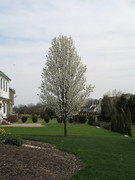
The grass came roaring back post our very hard winter. As of this point, I haven't fed it yet, it doesn't require feeding until mid-May at the earliest.
As always...well, click it. You know the drill. The dead tree lying there is what remains of the Hinoki cypress I cut down over the weekend. I've already removed a fair chunk of the sticks and twigs, and chopped part of the trunks off. I'll have that cleaned up long before the gardens get planted.
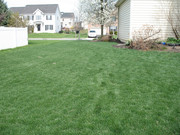
Saturday, April 26, 2014
Replacing the Hinoki Cypress
Our Hinoki cypress was unseated and tossed around by Hurricane Sandy back in October 2012. I knew the chances weren't good as the root systems were badly broken, but I reseated the tree and stanchioned it into place.
It did manage to survive until this winter, when the tree finally gave up.
Fortunately, I have a lilac I've kept dwarfed in another part of the garden that, frankly, really shouldn't be there. So today we dug up the cypress and replaced it with the lilac, which won't object to the transplanting and will enjoy that location just as much as it enjoyed its other one. It has the advantage that I don't have to dwarf it in its new home as well.
While transplanting, the root systems split into four, each with their own canes. Two bushes are now planted in other areas of the garden where they can also grow freely. And one went back into the location that the old bush came out of...oh well, I'll just dwarf it!
Transplanting a lilac is easy. Dig it up, take as much root mass as possible, and cut the canes back so they don't stress the roots too much. Place in new location, plant exactly as deeply as the place where it came out of, and water thoroughly post-transplant to settle the soil. In my case, I used a light mix of Miracle Gro to encourage the roots to grow back more quickly.
Lilacs strongly prefer near-neutral soil with good drainage and a high percentage of organic material. The organic material can be lower, however, and still grow a great lilac. They do demand at least 6 hours of sun per day (more is better) to bloom profusely.
Transplanted lilacs may bloom the next year if mature enough and if the root system you transplanted was large. Whips and suckers that are transplanted may need four to five years to bloom.
Friday, April 25, 2014
Holding Cold
Our average last frost date is April 20th, with the normal outside date May 15th.
This year, we look like we'll be receiving regular frosts and even a few light freezes through May 8th at the minimum, although the forecast that far out is unreliable at best. This could change at a moment's notice.
Still, I have plants downstairs that are starting to grow into the rafters (literally, the top shelf's lights are hung from the rafters, and the plants are now past the lights. The cleome and red salvia are particularly large, and so pot-bound in their little cells that they're starting to crawl out of them.
When this happens to you--and it probably will at some point--cease feeding and supply only water. You can also start the hardening off process under the lights at home.
First, put a fan on the plants to make the leaves and stems move. Shift the fan regularly to put it full strength on different flats. This will thicken the cuticles and stems, and train them to withstand winds. Although you can only get a ten to fifteen mile an hour equivalent wind on them, this will be sufficient to begin hardening them for outside life.
Second, run your hands over the top of the plants lightly once per day. Similarly, this will strengthen stems and leaves to withstand wind and other mechanical forces. It will also slow growth slightly as energy goes to thickening the skin and stem of the plant.
Third, let the plants wilt a bit before watering. This also strengthens the skin of the plant.
There's no substitute for sunlight and the plants will still need hardening off to the full light of the sun and the ultraviolet they haven't seen before. However, at the very least you can accomplish some of the hardening before you put the plants outside.
Tuesday, April 15, 2014
839
That was the final count on sprouted plants this year. While not a catchy number, it does mean I won't need much of anything from the local nursery this year.
Just for idle fun, here are approximate counts by species:
Zinnia: 370
Marigold: 180
Salvia farinacea: 75
Salvia splendens: 75
Celosia: 50
Cleome: 25
Easter Eggplant: 25
Melampodium: 25
Dahlia: 18
Saturday, April 12, 2014
Feeding the Thuja
I actually fed them late day Friday just before the showers came through.
Right now, this early in the season, I'm taking the easy way out. There's enough to do in the gardens that I don't have a vast amount of time to spend on smaller tasks.
So I wimped out and used some leftover 29-0-4 Vigoro fertilizer I had lying around. One small handful got thrown into the center of the bush to patter down and spread itself, while I spread more through where I know the roots go.
Since I was throwing things around anyway, I used about half Milorganite, half synthetic fertilizer to give a more sustained feed and add more iron to the mix.
Right now, the bushes are around 10-12 feet tall with a 5' diameter or so. Each bush received around 1/3 of a pound of 29-0-4, and 1/3 of a pound of Milorganite. The total instantly available nitrogen was approximately 0.1 pounds, with another 0.02 pounds of slowly available nitrogen.
I'll feed again in approximately two weeks, the fast way again. Once the gardens are in, I'll tend to use more Miracle Gro and Milorganite and table the 29-0-4 for the rest of the season. Feeding of the Thuja will continue through mid-August, at which point I stop to allow the bushes time to harden the new growth for winter.
Milk on the Lawn
Spring was delayed, but came on like gangbusters this year. It's currently around 70° F out there and absolutely perfect.
I spent most of the day putting down a bit over 1 tablespoon per thousand square feet of Prodiamine (Barricade), which will tend to deter weed sprout in the lawn and gardens for the next six months or so. I also treated the back patio and front walk to keep weeds from growing between the bricks. Effectiveness of the product is extremely good.
I washed that in with a gallon of milk spread over the lawn and gardens (the brick patio and walkway didn't get this, of course!), for about 8 ounces of milk per thousand. To that, I added around 4 ounces of humic acid and about 2 ounces of dissolved sodium laureth sulfate as a soil conditioner.
The sodium laureth sulfate helps soil bits conglomerate together instead of forming large plaques, increasing water penetration over time. The humic acid feeds the fungi in the lawn a little bit, assisting in water supply, nutrient supply, and general health.
The milk is...odd. It's not something I'd suggest adding unless your soil is tested and tuned fairly well, but it does seem to assist growth a little bit over a very long period of time. My idle guess is that an enzyme in there is similar enough to plant enzymes to unlock phosphorus from the soil matrix. But that's only a guess.
Over the next month, the milk will increasingly make the lawn a little greener, grow a little more strongly, and generally improve the look and durability. That advantage will maintain itself for the rest of the season.
Thursday, April 10, 2014
Too Late To Seed Now
As of today (which around here means plants will be put into the garden in around a month), it's now too late to start anything. If you didn't get there yet, you'll need to wait until next year to grow from seed.
The last of my plants went from the heater to the lights yesterday, and those were only 30 marigolds and zinnia that don't require much time. From here on out, I keep things watered, keep the lights on, and wait until they go out for hardening off around May fifth or so (give or take a few days).
While you could theoretically sneak in smaller, faster-developing marigolds like Janie or Durango if you plant immediately, they'll be very small when they go into your garden. That's not necessarily a disadvantage, although full growth and blooming will both be delayed.
Similarly, this is the wrong moment to seed your lawn (or feed it, for that matter). As of now, the new sprouts won't have time to develop good root systems before summer's heat hits. Feeding now simply taps the limited remaining carbohydrates from the grass roots and gives you lush growth--that won't survive the summer, and with tapped-out roots, there's no way for the plant to sustain the growth.
April is really a month to clean up, enjoy the blooming garden bulbs, and wait for the season to advance a bit. For me, garden planting will be around May 15th, with the lawn's first feeding following after the gardens have been planted.
Wednesday, April 9, 2014
More April Photos
While the planet just experienced its hottest month ever in January 2014, I was locked under a southern excursion of the polar vortex. That was unpleasant, but does have some positive side effects.
The Siberian iris, which have been limping along for years, actually got cold enough to fully set blossom. This year's blooms are fully colored, full-sized, and very pretty!
The photos below are close-ups, the actual plants are only about four to five inches tall total.
The purple iris (click to zoom in on the petal details):
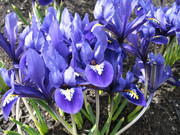
The blue iris (ditto, the image is zoomable):
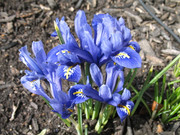
Thursday, April 3, 2014
April Lawn Photos
The snow has melted, and temperatures shot from the forties to the sixties pretty quickly. While the lawn definitely took a beating this winter, it should begin to recover shortly. Last year at this time we already had a fully green, growing lawn, this year growth hasn't resumed just yet. Soil temperatures are still a bit too cool for that.
You can see several patches of snow mold, which is unsurprising as the lawn spent most of the winter under snow and piles of snow from shoveling. This particular species of snow mold is pretty harmless, and the grass will recover with no issues. Those patches will simply be a bit slower.
As always, click on any image to embiggen it.

Bonus pic! The snow crocus just started to bloom as well, with this patch opening today. I missed capturing a native bee visiting the blooms by a few seconds. Again, these would normally blossom in early to mid March, but everything is late this year.
Click this one to embiggen and show off the stripes on the flowers!

Thursday, March 27, 2014
The Start of the Season
Well...sort of! Our temperatures are set to rise into the high fifties and sixties this weekend and onward (more or less May in April...again this year). I gave the Thuja and trees a light feeding since their roots are already awake (and in the Thuja's case, they're green and starting to perk up for spring).
In this case, I used some leftover Vigoro 29-0-4 mixed with quite a bit of Milorganite to give both a quick spike of nitrogen and an extended feeding through April.
I also purchased two packets of seeds--Mammoth sunflowers, the monsters that reach 15', and Chianti sunflowers, which grow to about 5' tall and bloom dark red. While Chianti sunflowers are poor performers compared to some other varieties, they should do well enough for where I want them. It's not a location connected to the main gardens.
Wednesday, March 26, 2014
Nearing the End Game
If you've been following along, you might remember that I miscalculated my number of plants by 1 flat. I ordered some Harlequin dahlia and Janie Flame marigold to fill that in, and I still have about a third of a flat of scarlet zinnia to go in there as well. Those haven't arrived, but should be here late this week or early next week, or in plenty of time.
The last of the current marigolds, Janie yellow and Janie orange, are sprouting now and almost ready to go downstairs under the lights. Everything else is already growing away down there, and the Easter Eggplant are actually getting fairly large.
I'm idly considering purchasing some red sunflower from my local grocery and cup starting those. Although tall, and not as long-season as I'd like, they might make an interesting accent in a few locations.
I did try some China Town celosia this year, and they sprouted well but didn't transfer to the four leaf stage very effectively. I'll have about half a flat opening up shortly when I transplant those into contiguous cells. I do have plenty of leftover seeds, ten of this, eight of that, to fill in.
Saturday, March 15, 2014
All Plants Start Now
Today marks 8 weeks until the end of frost, so for people in my gardening zone you can plant any seed you have. There's pretty much nothing that will overgrow the planting cells in that amount of time.
Except sunflower. Those you may wish to start in cups as they grow very quickly and dislike being transplanted.
As of today, the first of the Magellan zinnia started. Post this, I'll be planting marigolds, which fortunately don't require the full eight weeks (but do benefit from as much time as you can give them, so I'll shoot for six weeks or more).
Right now, there are six flats under the lights, two in my office sprouting, and four to go. At some point, probably early next week, I'll add a third to my office sprouting and perhaps a fourth.
Seeds that required longer periods should already be well-sprouted and into the four leaf stage. At that point, you can (very gently) feed them if you wish to. I fed very, very lightly today, 1/2 tsp of Miracle Gro in 2 gallons of water.
Tuesday, March 11, 2014
The First Zinnia
Technically, the first of the smaller zinnia. I'd started the Park's Deep Red and Envy zinnia at the beginning of the month. Both are now under the lights downstairs and the third rack of lights is now on.
As of today, I started the Persian Carpet zinnia as well as the Profusion zinnia (yellow, orange, and fire). While it's still a bit early and these will be extremely well-developed by the time they're ready to plant out, I don't have much choice.
Since I start 12 flats of plants, I have a limited time period to get everything started. This is now the sixth flat complete and either already sprouted and growing or on the heater and working on sprouting. That leaves six more flats to plant, sprout, and grow before early May.
So while I'm forced to start my smaller plants early, you still have some time. Short zinnia and marigold will do fine with four to six weeks before planting date. Eight to nine weeks simply gives them time to get very, very large (but conversely more difficult to adjust to life outside).
Next up, the Janie marigolds.
Wednesday, March 5, 2014
Most Plants Start Now
Plants that only take a very short time to grow, such as shorter zinnia and marigold, can be held and started as late as April first, but there's no disadvantage if you start these now as well.
Taller zinnia, marigolds, and most other plants benefit from eight weeks to grow until planting out, which means starting right about now is the correct time.
As of now, the cleome and Easter eggplant are growing downstairs under the lights. I recently added the Salvia farinacea "Rhea" and Salvia splendens (various red parents) to the growing rack as well. While small, they'll grow!
The taller zinnia are starting now, along with the Melampodium and celosia, which like a little more time than you might imagine (but are tolerant of not having it). I only bought 100 celosia seeds for a 72-cell flat, so I'm most likely going to have to find something else for the cells that inevitably don't sprout (this also involves pricking out baby plants and moving them into groups of cells to avoid mixing species inside a single 6-pack).
Next up, the shorter zinnia start, followed by the marigolds which are last on the list. The majority of my marigolds are Janie as they perform beautifully in heat and blossom well from May to frost (usually late October). They are, however, French marigold and rather short.
In other news, I think I'm a full flat short this year as I didn't plan for it correctly in early winter. No matter, it's an excuse to haunt places in the area that sell seed and pick up several new friends or revisit old ones!
I'll take photos of the lawn and gardens once the snow finishes melting. At the current rate, mid-March should be the starting point of the early spring season, but the first garden photos will be delayed by the weather this year. I don't expect the first flowers until late March.
Saturday, February 22, 2014
Salvia, Cleome, and Others Start Now
This is about the correct time to start any plant that takes a long time to flower or fruit if you wish it to be in full bloom (or full fruit) by the middle of the season.
For me, the cleome are already sprouted and under the lights in the cellar, as are the Easter eggplant. The Salvia farinacea and Salvia splendens are planted and spending a half day each on the heating mat. Once those are complete, the Melampodium (butter daisy) will begin.
Those cover the flowers I grow that benefit from longer growing periods.
Once those are complete, we'll be moving into early March and there will be 8 to 10 weeks left before planting. At that point, the tallest of the fast growers will be started, which this year includes the Envy zinnia, a tall and very chartreuse flower.
Friday, February 21, 2014
First Sprout
It was actually two days ago, but I wanted to make certain it wasn't a weed. It's difficult to tell the difference when the plant, like the cleome, is very small when it first sprouts.
It's definitely cleome, and most of the cells (I planted 24) have sprouts in them at this point. The ones that don't are at the edge of the flat, don't receive quite so much heat from the seed sprouting mat, and will be along shortly.
The Easter eggplant began to sprout today as well, much faster and much more reliably than last season. However, all the current seeds are descended off of plants that sprouted under my care and successfully grew in the garden, so that tends to be typical.
I started the Salvia farinacea "Rhea" yesterday. They also benefit from a longer growing season before being planted outside.
I'll start the Melampodium (butter daisy) this weekend, followed closely by the red salvia. While that ends the series that enjoys a longer growing period, the date at that point is late enough that even the short-growth plants can start.
Friday, February 14, 2014
Garden Planting Begins
Yes, we did get nearly twenty inches of snow yesterday, with more on the way tonight. Yes, I'd have to dig through that to even find the gardens at the moment. No, I'm not going to do that.
However, it's time to start the plants for spring! Traditionally, in this household, the cleome begins on Valentine's Day as it benefits from three full months to grow. I've also begun the Easter eggplant as it would benefit from an extra week more than I gave it last year.
As of right now, both have been pulled in from the garage (where the seeds were vernalizing in near-freezing temperatures) and set on the heating mat, which will raise the soil temperature to eighty in just a few hours.
Cleome benefits from temperature oscillation as well, so I'll turn off the heater tomorrow morning and start it again on Saturday evening. That process will continue until the seeds sprout, which doesn't take terribly long if they were vernalized. The cleome should be fully sprouted by mid-week, at which point I'll begin the Salvia farinacea, which also requires a longer growing time before planting in May.
Snow on the Lawn
Since there's currently two feet of snow out there atop the lawn and it's still coming down fast, this comes to mind. We're certainly not going to be leaving the house tomorrow.
There's very little you can do to prepare your lawn for a heavy snowfall as it will already be dormant by the time snowfalls of that depth occur. The best preparation is in fall, and to winterize the lawn with about 1 pound of nitrogen per thousand to make certain it has the stored carbohydrates to get through the season.
Similarly, there is no effective treatment. Shoveling would take a very long time and runs the risk of damaging root systems if you accidentally shovel too deeply. The problem also arises of where to put the snow.
The only thing you can do is wait out Mother Nature and hold on for spring. Once it melts and the soil warms, the grass will return and probably be no worse for the experience!
Wednesday, February 5, 2014
Happy Solar Spring!
February 5th marks the beginning of Solar Spring, the 12 weeks of the year when the daylight period increases the fastest in the northern hemisphere. Roughly, the period starts with Groundhog's Day and ends with May Day (for historical and calendar reasons, the periods are slightly out of synch).
Although the weather here is definitely still winter, and contains the possibility of significant snow over the next week, at least it's nice to notice the lengthening days!
Vernalization
Vernalization is adjusting seeds to a winter environment, which can be useful for seeds that require a cold period before sprouting. With the seeds I have, only the cleome benefits significantly from it, while the Easter eggplant finds it mildly helpful but not necessary. However, since I have to vernalize the cleome, the Easter eggplant goes along for the ride.
The process is very simple. Place the seeds in their starter trays and moisten them just as you would when sprouting any other seed. The place the starter tray in a cool to cold environment, by preference one that doesn't regularly freeze. I use the garage and keep the trays toward the interior wall. Temperatures may occasionally drop below freezing, but generally stay around 32.
The refrigerator can be another good place to vernalize seeds if a garage isn't handy, and you can put them in a damp, covered glass.
Vernalization generally requires about six weeks in the colder environment. Post that period, remove whenever you like and grow normally.
Any seed from any tropical or sub-tropical plant will never require vernalization and at best won't benefit from it. Marigolds, zinnia, salvia, celosia, and most other common summer garden plants don't require vernalization and may not survive in low temperatures.
Monday, February 3, 2014
Lawn and Garden: Early February
Normally I would have posted several shots of the very green grass as compared to the rest of the neighborhood. This year, that's not going to happen.
When it isn't snowing, it's incredibly cold. When it's not incredibly cold, it's snowing. The grass is still amazingly green, but buried under (currently) six inches of snow, with more to come yet this week.
At the very least, I've vernalized the cleome and Easter eggplant seeds. From Christmas night to now they've been in the garage on the face nearest the interior of the house, experiencing winter. I'll bring them in around Valentine's Day and begin sprouting both, then start other plants as there's room on my seed sprouting heater.
Here's the current grass and garden photo. As always, click to embiggen.
